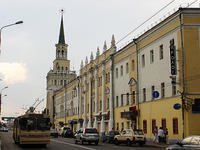You are in: Europe -> Russia -> Historical Centre of... , and traditional search or Image Gallery will yield results of this site only
Historical Centre of the City of Yaroslavl
| Site number: | 1170 |
|
| Type of site: | Cultural | |
| Date: | 11th century | |
| Date of Inscription: | 2005 | |
| Location: | Eurasia, Russian Federation, Yaroslavl Oblast | |
Up to 75 images are shown here. Click on each for more details or on Image Gallery for more images.
| Description: | The historic city of Yaroslav sits some 250km northeast of Moscow, where the Volga and Kotorosl rivers convene; as of the 11th century it developed into the foremost commercial centre. It is celebrated for its abundant 17th century churches and wonderfully exhibits Empress Catherine the Great’s urban planning reform, which she ordered for the whole of Russia in 1763. The town was renovated in the neo-classical style on a radial urban master plan, while still upholding a number of its major historic structures. The Spassky Monastery, among the Upper Volga region’s oldest, was built in the late 12th century on the site of a pagan temple, but overtime reconstructed; it has to this day maintained its 16th century elements. --WHMNet paraphrase from the description at WHC Site, where additional information is available. | |
| Yaroslavl (Russian: Яросла́вль) is a city in Russia, the administrative center of Yaroslavl Oblast, located 250 km north-east of Moscow. The historical part of the city, a World Heritage Site, is located at the confluence of the Volga and the Kotorosl Rivers. As of the 2002 Census, its population was 613,088. Yaroslavl lies at the intersection of several major highways, railways, and waterways. Preceded by Viking sites such as Timerevo from the 8th or 9th centuries, the city is said to have been founded in 1010 as an outpost of the Principality of Rostov Veliky, and was first mentioned in 1071. Capital of an independent principality from 1218, it was incorporated into Muscovy in 1463. In the 17th century it was Russia's second largest city, and for a time (during the Polish occupation of Moscow in 1612), the country's de facto capital. Today, Yaroslavl is an important industrial center (petrochemical plant, tire manufacturing plant, diesel engines plant and many others). Apart from the Spaso-Preobrazhensky (Transfiguration of the Saviour) Monastery the oldest churches in the city date back to the 17th century and belong to the so called Yaroslavl type (built of red brick, with bright tiled exteriors). Those of St. Nicholas Nadein and Elijah the Prophet have some of the Golden ring's most impressive frescoes. Temples: the city has many Russian Orthodox churches, one Russian Old Believers church, one Baptist church, one Lutheran church, one mosque and one synagogue. Yaroslavl is divided into six city districts. The center is located on the northern bank of the Kotorosl where it converges with the Volga, on the Volga's western bank. The Center is the economic and political center of the city. The center is also the oldest district in the city, where the city was first settled. The center contains the majority of landmarks and attraction in the city, including the Volkov theater, the Church of Elijah the prophet, the soccer stadium, the Volga embankment and the monastery, often mistakenly called the kremlin. Pyatyorka is located north of the center, but still under its administrative jurisdiction. Pyatyorka is largely a residential region with very little of note, aside from a few Houses of Culture. --Wikipedia. Text is available under the Creative Commons Attribution-ShareAlike License. | ||
| Source: | http://whc.unesco.org/en/list/1170 | |
| Reference: | 1. UNESCO World Heritage Center, Site Page. | |



















